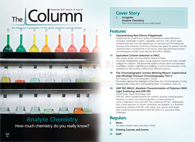Characterizing Red Chicory Polyphenols
Polyphenols are a well-known group of antioxidants widely diffused as secondary metabolites in plants, vegetables, and fruit. The Column spoke to Nicola Marchetti from the Department of Chemistry and Pharmaceutical Sciences at the University of Ferrara in Ferrara, Italy, about his research into the characterization of polyphenols in red chicory using high performance liquid chromatography–tandem mass spectrometry (HPLC–MS/MS).
Photo Credit: Frank Bach/Shutterstock.com

Polyphenols are a well-known group of antioxidants widely diffused as secondary metabolites in plants, vegetables, and fruit. The Column spoke to Nicola Marchetti from the Department of Chemistry and Pharmaceutical Sciences at the University of Ferrara in Ferrara, Italy, about his research into the characterization of polyphenols in red chicory using high performance liquid chromatography–tandem mass spectrometry (HPLC–MS/MS). -Interview by Kate Mosford
Q. Your work focuses on the characterization of polyphenols in red chicory using HPLC–MS/MS (1). What led you to begin this research?
A: It was an interesting and unique merge between the specific needs of my department, who wanted to strengthen the food chemistry research area, and my personal interests that I wanted to develop. Since 2010 I have been involved in several multidisciplinary projects where my expertise with liquid chromatography (LC) and mass spectrometry (MS) was required. This current opportunity meant that I could apply all my knowledge and know-how that I have acquired in separation science and LC tandem MS analysis with complex samples to food chemistry and nutraceutics. Prior to this, I had already had several opportunities to collaborate with other groups on similar topics with high applicative and industrial relevance, such as role and degradation of antioxidants in cosmetics and pharmacological effects of natural substances. One of these collaborative works was about the employment of novel solid microparticles as a vehicle for nose-to-brain targeting antimigraine drugs (2,3). Since then, I have been fascinated by different multidisciplinary aspects of nutraceutics, such as bioactivity, biochemical role, and microencapsulations of phytocompounds for novel food and supplements development. Polyphenols are a well-known group of antioxidants widely diffused as secondary metabolites in plants, vegetables, and fruit. Red chicory, particularly those varieties from the southern Po Delta area, is still not a fully characterized matrix against flavonoids and other polyphenolics.
Q. Did red chicory present any chromatographic challenges to fully characterize?
A: Before answering, I need to outline a few specifications useful to the discussion. Usually real samples of natural origin, such as foodstuffs, biologic fluids, or tissues, are very difficult to analyze. This is mainly because of the large number of compounds that are simultaneously separated and detected in the mass spectrometer. This scenario necessarily requires the use of extensive and proper sample preparation, extraction, fractionation, and cleanup steps. Loss of analytes by degradation or low recovery is the most frequent drawback for these procedures. Thus, conservative compromises must be addressed daily and challenging efforts have to be made by the analyst to separate different molecules and compound classes.
In addition, when tandem MS is used to fully characterize complex samples and identify unknown compounds, method optimization and setup is a time-consuming procedure. Procedures that supply accurate data analysis of MS/MS transitions and resolution of tentative structures are almost all made manually by the analyst.
Chromatographic challenges are important and represent the second hurdle that must be faced, after sample extraction. If high performance liquid chromatography (HPLC) or gas chromatography (GC) separations are not properly made, all further considerations will hardly come to a positive conclusion.
Indeed, characterization of red chicory extracts with regards to phenolic acids and glycosylated polyphenolics is difficult when polyglycosylated species and complex esterified molecules have to be newly and precisely identified. I was able to overcome difficulties for component identification in some cases, such as for di-glucosyl-malonyl derivatives.
Q. What is novel about your research and what were your main findings? Was there anything you were particularly surprised by?
A: I am trying to find relationships between structures of phenolic acids (PA) and polyphenols (PP) and their bioaccessibility profiles during the digestion steps. There are many studies in the literature on the correlation between structure and antioxidant activity (4). Insights into the possible links between molecular structure and the way PA and PP are released by the food matrix is the novel aspect of my research. These investigations have already provided interesting findings and more are coming soon (1). Other original aspects of this research regard implications of structure-bioaccessibility relationships (SBRs) on health and disease prevention. These studies can help to obtain unique information on the bioactivity and biochemical role of PA and PP and this can give strong impulse to the development of novel, functional, and enriched foods, and innovative formulation of food supplements and ingredients (that is, microencapsulations).
And last but not least, all the analyses that have been done can be used and pooled with biological analyses (that is, genetics) to find differences in bioactive profiles between species. This represents the first step towards acquisition of food authenticity labels for both fresh products (vegetables and crops) and processed food.
Here in Italy this research topic is fundamental within food chemistry to protect biodiversity and cultivars, and to maintain high quality levels in food.
Q. What can HPLC–MS/MS offer for this analysis over other techniques?
A: Everyone knows that HPLC–MS/MS is a superior technique because of its high sensitivity, versatility, speed, and informative aspects of the MS detector. In addition, HPLC instrumentation and column technology have experienced huge steps forward and important implementations in recent years. Analysts now have the opportunity to work with advanced equipment capable of outstanding performances (efficiency, separation speed, exercise pressure, reproducibility, green impact). On the other hand, fundamental investigations on the separation mechanisms involved in LC and recent findings on new column and instrument technology were the main reasons for the strong interest that HPLC has received in the last 10 years. New and more stable column chemistries are now available, with packing particles even smaller, and chiral liquid chromatography is one of the beneficiaries of this development.
Q. Do you have any advice to chromatographers who are new to tandem mass spectrometry?
A: Today, novel or experienced researchers that wish to use MS have plenty of resources available: webinars, books, summer-schools, on-site training by companies. Thus, I really do not have particular advice to offer for MS, except to be very careful to choose the right type of instrument for your needs.
I wish to say a few words, instead, to those researchers that are approaching MS and do not have expertise in HPLC either. I believe that to ensure good LC–MS analysis you must carefully consider both aspects, separation and detection. I strongly advise them that a good HPLC separation is the most important step to obtain reliable MS spectra and successful results.
To conclude, MS/MS experiments and data interpretation require good knowledge of organic chemistry to more easily get tentative structures and MS/MS transitions correct.
Q. What are your next steps with this research?
A: I want to extend these studies to other compound classes and other cultivars. It is my opinion that other type of bioactivites can be exploited, such as antidiabetic and antihyperglycemic. Anyway, there are many aspects of antioxidant activity that still require deeper investigation, particularly with regards to antiproliferative and antitumoral effects.
Q. Please could you talk a little on your research into the effect of red chicory on cancer cells.
A: Interdisciplinary studies we have made in collaboration with molecular biologists clearly indicate that phenolic acids have a larger antiproliferative effect as long as they can enter inside cells. The antioxidant activity exerted by polyphenolics, and in particular by those bound to dietary fibres, is totally different and less effective. In the case of phenolic acids, I’m talking about a systemic routed activity where phenolic acids can go inside cells and promote apoptosis of cancer cells. This activity can strongly vary by little structural modifications of natural phenolics. It is very important to find these activities.
In addition, the concentration of bioactive phytocompounds is in most cases largely below the pharmaceutical dose, and often below that required to see an impact on cells. Our findings revealed that complex esterified phenolic acids can be degraded to constituent molecules and that this process can be enhanced by a synergic effect between an enzyme and probiotic microorganism. This allows a sufficient production of bioactive phenolic acids to promote an antiproliferative response on dangerous cells. This information is necessary to effectively choose ingredients for novel or enriched foods.
Acknowledgements
I wish to acknowledge the EmiliaâRomagna Region and its High Technology Network for giving us the opportunity to join projects and collaborations with other research groups of the Technopoles and Technology Hubs from the region where my University is located. Several projects were granted by Emilia-Romagna Region and made possible by means of the European Regional Development Fund Operational Programmes (ROP-ERDF) 2007-2013 and 2014-2020. The regional administration identified a smart specialization strategy to develop specific productive sectors of regional economy by a paradigm shift: Universities and Small-MediumâEnterprises started to collaborate and to converse on using academic know-how and expertise to solve problems for the industrial and productive sectors. This also happened for food chemistry with different subâtopics, such as food security, food safety, technologies for product shelf-life extension, and enriched and novel food with health implications.
References
- C. Bergantin, A. Maietti, A. Cavazzini, L. Pasti, P. Tedeschi, V. Brandolini, and N. Marchetti, Journal of Functional Foods 33, 94–102 (2017).
- A. Dalpiaz, N. Marchetti, A. Cavazzini, L. Pasti, S. Velaga, E. Gavini, S. Beggiato, and L. Ferraro, Journal of Chromatography B 901, 72–78 (2012).
- E. Gavini, G. Rassu, L. Ferraro, S. Beggiato, A. Alhalaweh, S. Velaga, N. Marchetti, P. Bandiera, P. Giunchedi, and A. Dalpiaz, European Journal of Pharmaceutics and Biopharmaceutics 83, 174–183 (2013).
- K.E. Heim, A.R. Tagliaferro, and D.J. Bobilya, Journal of Nutritional Biochemistry 13, 572–584 (2002).
Nicola Marchetti was born in 1976. He has a master’s degree in chemistry and received his Ph.D. in chemical sciences from the University of Ferrara (Ferrara, Italy) in 2005. He was a postdoc researcher fellow at the University of Tennessee (Knoxville, Tennessee, USA) from 2006 to 2008, in the group of Georges Guiochon. He returned to Italy and was appointed as fixed-term Assistant Professor at the University of Ferrara from 2010. Now he is Senior Assistant Professor and his research activities focus on sample extraction and LC–MS/MS analyses, particularly quali-quantitative analytical characterization of complex matrices of food origin and insights into the bioactivity of phytocomponents.
E-mail:nicola.marchetti@unife.itWebsite:http://docente.unife.it/docenti-en/nicola.marchetti

Analytical Challenges in Measuring Migration from Food Contact Materials
November 2nd 2015Food contact materials contain low molecular weight additives and processing aids which can migrate into foods leading to trace levels of contamination. Food safety is ensured through regulations, comprising compositional controls and migration limits, which present a significant analytical challenge to the food industry to ensure compliance and demonstrate due diligence. Of the various analytical approaches, LC-MS/MS has proved to be an essential tool in monitoring migration of target compounds into foods, and more sophisticated approaches such as LC-high resolution MS (Orbitrap) are being increasingly used for untargeted analysis to monitor non-intentionally added substances. This podcast will provide an overview to this area, illustrated with various applications showing current approaches being employed.
Extracting Estrogenic Hormones Using Rotating Disk and Modified Clays
April 14th 2025University of Caldas and University of Chile researchers extracted estrogenic hormones from wastewater samples using rotating disk sorption extraction. After extraction, the concentrated analytes were measured using liquid chromatography coupled with photodiode array detection (HPLC-PDA).
Silvia Radenkovic on Building Connections in the Scientific Community
April 11th 2025In the second part of our conversation with Silvia Radenkovic, she shares insights into her involvement in scientific organizations and offers advice for young scientists looking to engage more in scientific organizations.











